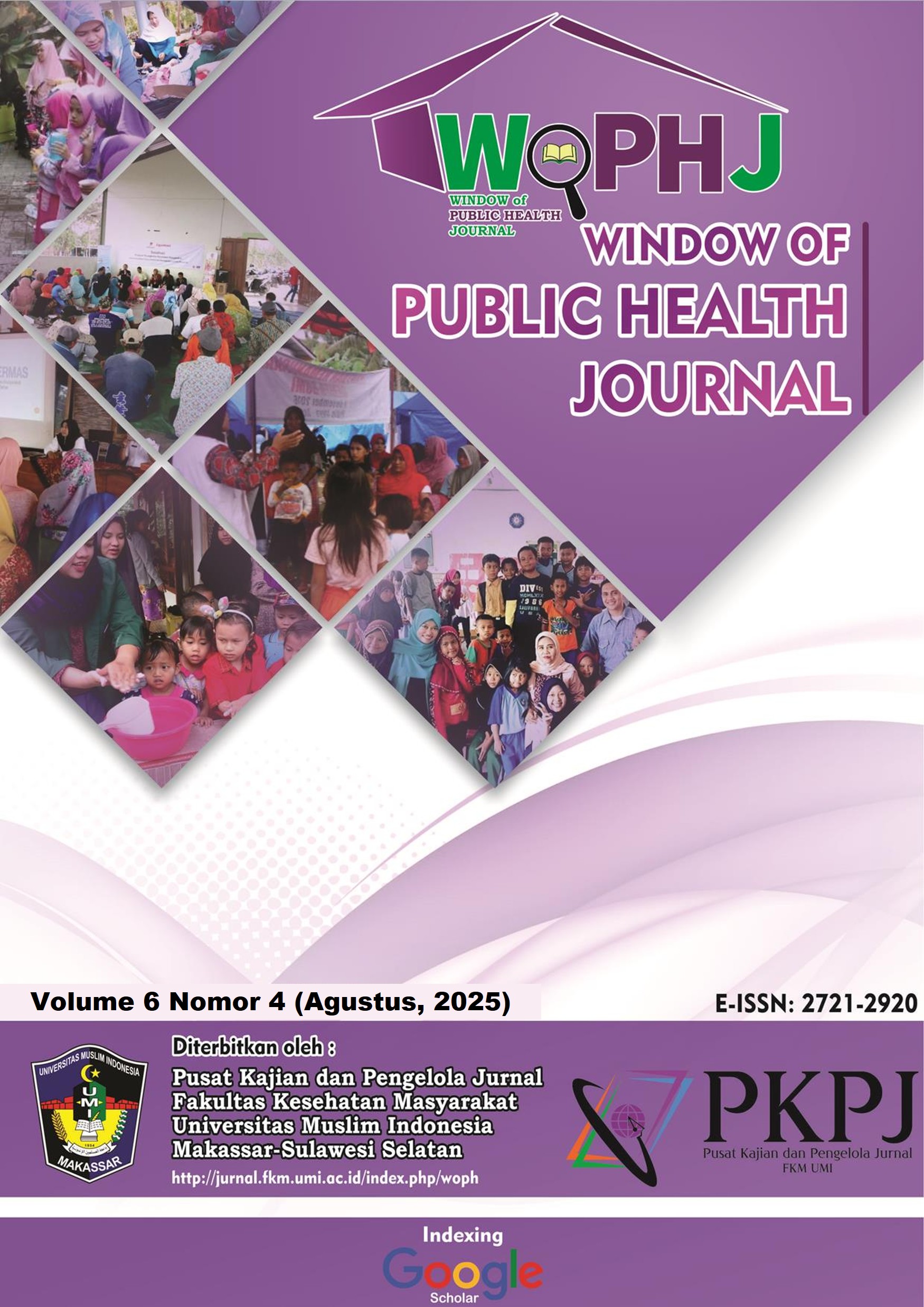Hubungan Riwayat Keluarga Dan Aktivitas Fisik Dengan Hipertensi Pada Ibu Hamil Di Puskesmas Asera
DOI:
https://doi.org/10.33096/s0y71444Keywords:
Hypertension, Physical activity, PregnancyAbstract
Hypertension in pregnant women is a serious health problem that contributes to high rates of maternal and fetal morbidity and mortality. This study, conducted at the Asera Community Health Center, North Konawe Regency, aimed to determine the relationship between family history and physical activity and hypertension incidence in pregnant women. The observational analytic study with a case-control design, involved 38 pregnant women as respondents selected through a total sampling technique. Data was collected using questionnaires and medical records, and then analyzed using the Chi-Square test. The results showed a significant relationship between a family history of hypertension (p = 0.000) and physical activity (p = 0.021) with the incidence of hypertension in pregnant women. The conclusion of this study is that a family history of hypertension and low physical activity increase the risk of hypertension in pregnant women. These findings have important implications for health promotion and prevention efforts, providing a basis for strategies to prevent complications of hypertension in pregnant women.
References
[1] W. H. Organization, “Trends in Maternal Mortality 2000 to 2017: Estimates by WHO, UNICEF, UNFPA, World Bank Group and the United Nations Population Division,” WHO, 2021.
[2] L. A. Magee, P. von Dadelszen, and et al., “Hypertensive disorders of pregnancy,” Nat. Rev. Dis. Prim., vol. 8, no. 1, pp. 23–40, 2022, doi: 10.1038/s41572-022-00344-4.
[3] U. N. P. F. (UNFPA), “State of World Population 2021: My Body is My Own,” UNFPA, 2021.
[4] K. K. R. Indonesia, “Profil Kesehatan Indonesia 2022,” Kementerian Kesehatan RI, 2022.
[5] E. A. P. Steegers and P. von Dadelszen, “Preeclampsia,” N. Engl. J. Med., vol. 382, no. 12, pp. 1122–1131, 2020, doi: 10.1056/NEJMra1909717.
[6] S. Rana and E. Lemoine, “Preeclampsia: Pathophysiology and management strategies,” BMJ, vol. 378, p. e070907, 2022, doi: 10.1136/bmj-2022-070907.
[7] L. Duley, “The global impact of pre-eclampsia and eclampsia,” Semin. Perinatol., vol. 44, no. 1, pp. 151–155, 2020, doi: 10.1016/j.semperi.2019.07.010.
[8] M. A. Brown and L. A. Magee, “The hypertensive disorders of pregnancy: ISSHP classification, diagnosis & management recommendations for international practice,” Pregnancy Hypertens., vol. 33, pp. 211–229, 2023, doi: 10.1016/j.preghy.2023.05.001.
[9] G. H. and P. A. P. Bulletin, “Gestational Hypertension and Preeclampsia,” Obstet. Gynecol., vol. 135, no. 6, pp. e237–e260, 2020, doi: 10.1097/AOG.0000000000003891.
[10] B. M. Sibai, “Preeclampsia as a cause of maternal and perinatal morbidity and mortality,” Semin. Perinatol., vol. 44, no. 1, pp. 151–158, 2020, doi: 10.1053/j.semperi.2019.07.010.
[11] B. W. Mol and C. T. Roberts, “Pre-eclampsia,” Lancet, vol. 397, no. 10281, pp. 120–136, 2021, doi: 10.1016/S0140-6736(20)32335-7.
[12] E. Abalos, C. Cuesta, and A. L. Grosso, “Global and regional estimates of preeclampsia and eclampsia,” Int. J. Gynecol. Obstet., vol. 152, no. 1, pp. 16–27, 2021, doi: 10.1002/ijgo.13534.
[13] E. Phipps and D. Prasanna, “Preeclampsia: Updates in pathogenesis, definitions, and guidelines,” Clin. J. Am. Soc. Nephrol., vol. 15, no. 10, pp. 1371–1383, 2020, doi: 10.2215/CJN.12091019.
[14] J. P. Souza, “Maternal near miss and hypertensive disorders of pregnancy,” Best Pract. Res. Clin. Obstet. Gynaecol., vol. 76, pp. 41–52, 2021, doi: 10.1016/j.bpobgyn.2021.01.004.
[15] L. Say and D. Chou, “Maternal mortality estimates and contributing causes,” Reprod. Health, vol. 19, no. 1, p. 190, 2022, doi: 10.1186/s12978-022-01511-7.
Downloads
Published
Issue
Section
License
Copyright (c) 2025 Harmawati Rustan

This work is licensed under a Creative Commons Attribution-NonCommercial-ShareAlike 4.0 International License.







